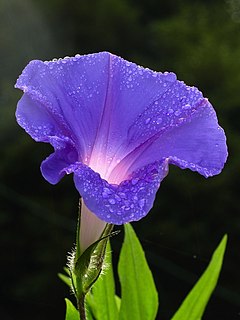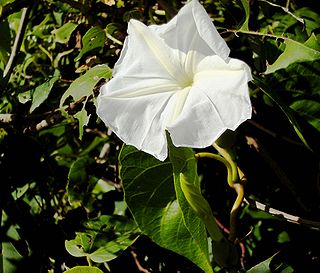
Convolvulaceae, known commonly as the bindweed or morning glory family, is a family of about 60 genera and more than 1,650 species of mostly herbaceous vines, but also trees, shrubs and herbs, and also including the sweet potato and a few other food tubers.

Xōchipilli[ʃoːt͡ʃiˈpilːi] is the god of art, games, dance, flowers, and song in Aztec mythology. His name contains the Nahuatl words xōchitl ("flower") and pilli and hence means "flower prince".

Morning glory is the common name for over 1,000 species of flowering plants in the family Convolvulaceae, whose current taxonomy and systematics are in flux. Morning glory species belong to many genera, some of which are:

Ergine, also known as d-lysergic acid amide (LSA) and d-lysergamide, is an ergoline alkaloid that occurs in various species of vines of the Convolvulaceae and some species of fungi. The psychedelic properties in the seeds of ololiuhqui, Hawaiian baby woodrose and morning glories have been linked to ergine and/or isoergine, its epimer, as it is the dominant alkaloid present in the seeds.

Ergoline is a chemical compound whose structural skeleton is contained in a variety of alkaloids, referred to as ergoline derivatives or ergoline alkaloids. Ergoline alkaloids, one being ergine, were initially characterized in ergot. Some of these are implicated in the condition ergotism, which can take a convulsive form or a gangrenous form. Even so, many ergoline alkaloids have been found to be clinically useful. Annual world production of ergot alkaloids has been estimated at 5,000–8,000 kg of all ergopeptines and 10,000–15,000 kg of lysergic acid, used primarily in the manufacture of semi-synthetic derivatives.

Lysergic acid, also known as D-lysergic acid and (+)-lysergic acid, is a precursor for a wide range of ergoline alkaloids that are produced by the ergot fungus and found in the seeds of Turbina corymbosa (ololiuhqui), Argyreia nervosa, and Ipomoea tricolor.

Argyreia nervosa is a perennial climbing vine native to the Indian subcontinent and introduced to numerous areas worldwide, including Hawaii, Africa, and the Caribbean. Though it can be invasive, it is often prized for its aesthetic and medicinal value. Common names include Hawaiian baby woodrose, adhoguda अधोगुडा or vidhara विधारा (Sanskrit), elephant creeper and woolly morning glory. Its seeds are known for their powerful entheogenic properties, greater or similar to those of Ipomoea species, with users reporting significant psychedelic and spiritual experiences. The two botanical varieties are A. n. var. nervosa described here, and A. n. var. speciosa, which are used in Ayurvedic medicine for their medicinal value.
Xtabentún is an anise liqueur made in Mexico's Yucatán region from anise seed, and fermented honey produced by honey bees from the nectar of xtabentún flowers. Rum is then added to the anise and honey mixture. Because of the rum content, the xtabentún liqueur is sometimes called a "distilled honey" beverage, which is misleading, because the honey alcohol is fermented, not distilled. It is, nonetheless, a spirit beverage, since rum, a distilled product, is added. Distilleries still survive today in the Yucatán that produce the liqueur.

The ancient Aztecs employed a variety of entheogenic plants and animals within their society. The various species have been identified through their depiction on murals, vases, and other objects.

D-Lysergic acid α-hydroxyethylamide, also known as D-lysergic acid methyl carbinolamide, is an alkaloid of the ergoline family, believed to be present in small amounts in various species in the Convolvulaceae, as well as some species of fungi.

Lysergol is an alkaloid of the ergoline family that occurs as a minor constituent in some species of fungi, and in the morning glory family of plants (Convolvulaceae), including the hallucinogenic seeds of Rivea corymbosa (ololiuhqui), Argyreia nervosa and Ipomoea violacea. Lysergol is not a controlled substance in the USA. Its possession and sale is also legal under the U.S. Federal Analog Act because it does not have a known pharmacological action or a precursor relationship to LSD, which is a controlled substance. However, lysergol is an intermediate in the manufacture of some ergoloid medicines.

Datura innoxia, known as pricklyburr, recurved thorn-apple, downy thorn-apple, Indian-apple, lovache, moonflower, nacazcul, toloatzin, toloaxihuitl, tolguache or toloache, is a species of flowering plant in the family Solanaceae. It is more rarely called sacred datura, a common name which is applied more often to the closely related Datura wrightii. It is native to the Southwestern United States, Central and South America, and introduced in Africa, Asia, Australia and Europe. The scientific name is often cited as D. innoxia. When English botanist Philip Miller first described the species in 1768, he misspelled the Latin word innoxia (inoffensive) when naming it D. inoxia. The name Datura meteloides was for some time erroneously applied to some members of the species, but that name has now been abandoned.

Jonathan Ott is an ethnobotanist, writer, translator, publisher, natural products chemist and botanical researcher in the area of entheogens and their cultural and historical uses, and helped coin the term "entheogen".

Ipomoea violacea is a perennial species of Ipomoea that occurs throughout the world with the exception of the European continent. It is most commonly called beach moonflower or sea moonflower as the flowers open at night.

Desmanthus leptolobus, known as prairie mimosa, prairie bundleflower or slenderlobe bundleflower, is a flowering plant of the genus Desmanthus. It is native to Kansas, Oklahoma, and Texas and has spread to Missouri and New Mexico. It is often locally abundant over large expanses of rolling prairie.

Echinopsis pachanoi —known as San Pedro cactus—is a fast-growing columnar cactus native to the Andes Mountains at 2,000–3,000 m (6,600–9,800 ft) in altitude. It is found in Argentina, Bolivia, Colombia, Chile, Ecuador and Peru, and it is cultivated in other parts of the world. Uses for it include traditional medicine and traditional veterinary medicine, and it is widely grown as an ornamental cactus. It has been used for healing and religious divination in the Andes Mountains region for over 3,000 years. It is sometimes confused with its close relative Echinopsis peruviana.

The peyote is a small, spineless cactus which contains psychoactive alkaloids, particularly mescaline. Peyote is a Spanish word derived from the Nahuatl peyōtl, meaning "caterpillar cocoon", from a root peyōni, "to glisten". Peyote is native to Mexico and southwestern Texas. It is found primarily in the Sierra Madre Occidental, the Chihuahuan Desert and in the states of Nayarit, Coahuila, Nuevo León, Tamaulipas, and San Luis Potosí among scrub. It flowers from March to May, and sometimes as late as September. The flowers are pink, with thigmotactic anthers.

Albert Hofmann was a Swiss chemist known best for being the first to synthesize, ingest, and learn of the psychedelic effects of lysergic acid diethylamide (LSD). Hofmann's team also isolated, named and synthesized the principal psychedelic mushroom compounds psilocybin and psilocin. He authored more than 100 scientific articles and numerous books, including LSD: Mein Sorgenkind. In 2007, he shared first place with Tim Berners-Lee in a list of the 100 greatest living geniuses, published by The Daily Telegraph newspaper.
The consumption of hallucinogenic plants as entheogens goes back to thousands of years. Psychoactive plants contain hallucinogenic particles that provoke an altered state of consciousness, which are known to have been used during spiritual rituals among Mexican subcultures such as the Aztec, the Maya, and Inca. The Maya were indigenous people of Mexico and Central America that had significant access to hallucinogenic substances. Archaeological, ethnohistorical, and ethnographic data show that Mesoamerican cultures used psychedelic substances in therapeutic and religious rituals. The consumption of many of these substances dates back to the Olmec era ; however, Mayan religious texts reveal more information about the Aztecs and Mayan civilization. These substances are considered entheogens because they were used to communicate with divine powers. "Entheogen," an alternative term for hallucinogen or psychedelic drug, derived from ancient Greek words ἔνθεος and γενέσθαι. This neologism was coined in 1979 by a group of ethnobotanists and scholars of mythology. Some authors claim entheogens have been used by shamans throughout history, with appearances in prehistoric cave art such as a cave painting at Tassili n'Ajjer, Algeria that dates to roughly 8000 BP. Shamans in Mesoamerica served to diagnose the cause of illness by seeking wisdom through a transformational experience by consuming drugs to learn the crisis of the illness


















